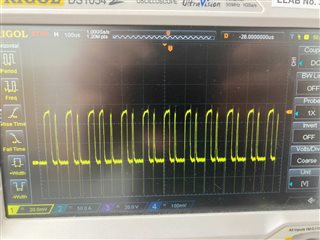Hi All!
I have recently designed an economizer board for electromechanical brakes on BLDC motors using the DRV110. When testing it I realized that it generates very audible and unpleasant hissing on the brakes although the regulation frequency of 20kHz (0R at Rosc) should be way above my audio range. Except from that the circuit does what it should so I did some investigation.
One is that one long pulse is in all configurations I tried (different Rosc, current measurement filters, power supply filter etc) a lot longer than the next one, thus resulting in a "frequency-halfing" effect (see picture from filtered SENSE signal, please excuse the mediocre quality. I suspect that is due to the hysteresis control. Is there anything I can do about it? Supply voltage, brake (and thus inductance) and currents are unfortunately fixed, all suggestions I found so far to suboptimal regulation were changing one of these parameters.

Another thing I realized is that the supply voltage regulation ripple is rather high, even when using massive input filter caps and a series resistor close to the minimum rating. When I supply the IC externally the audible noise gets a lot less unpleasant, so I suspect that the reference voltage is derived from the supply and the ripple induces some interferences. The sound also distinctively changes when adding or removing capacitance. In the datasheet now I found a lot of references to the input zener diode, but on p12 it is a "zener-like" circuit - what is now the real way the input is regulated? Anyway, the result is really not nice, I will add an additional LDO per DRV110, but it would be nice to know whether there is also an easier way.
kind regards,
Tobias Schwering

